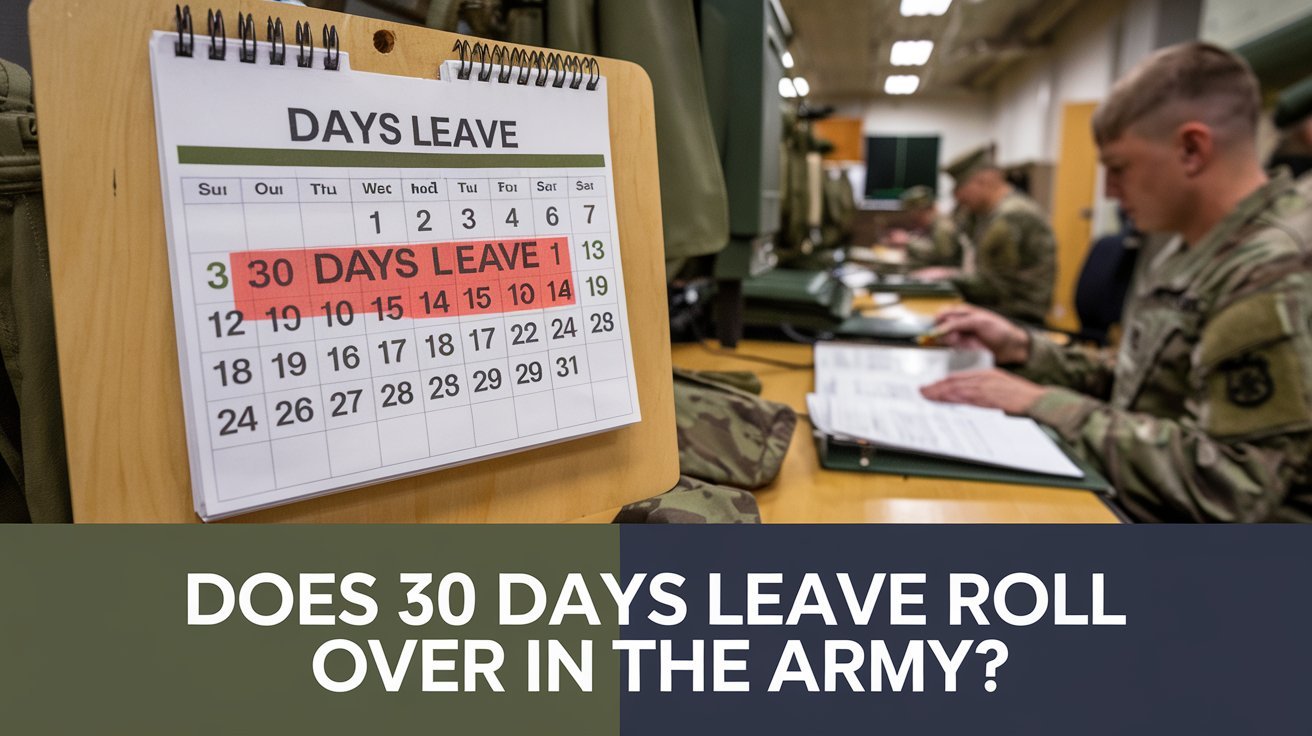Does 30 Days Leave Roll Over Army? Policy Details

Being in the U.S. military means you need to know about your leave and how it works. Many ask if their 30 days of annual leave can carry over to the next year. The answer depends on the military’s leave rules and special cases.
Service members get 30 days of paid leave each year. They earn 2.5 days for every month they serve. Usually, you can carry over up to 60 days of leave, but some situations allow more.
Reserve members, like those in the National Guard, also earn leave at the same rate when they’re on duty. It’s important to plan your leave well. This way, you can enjoy the leave you’ve earned.
Basic Army Leave Accrual System
Active duty soldiers in the U.S. Army get 2.5 days of annual leave each month. This adds up to 30 days a year. Reservists who serve for 30 days or more also earn leave under this rule.
Monthly Leave Calculation
The Army’s leave policy is simple. Soldiers get 2.5 days of leave every month. This helps them plan their time off and balance work and life.
Active Duty vs. Reserve Component Accrual
Active duty and reserve soldiers follow the same leave policy. Reservists must be on duty for 30 days or more to earn leave. This rule makes sure everyone is treated fairly.
Fiscal Year Considerations
The Army’s fiscal year ends on September 30th. Leave that’s more than 60 days is lost at the start of the next year. Soldiers can check their leave on the myPay platform.
Knowing how the Army’s leave system works is key. It helps soldiers manage their time off well. By planning ahead, they can balance their military duties with personal life.
Does 30 Days Leave Roll Over Army
The usual limit for carrying over regular leave is 60 days. But, a new rule limits Special Leave Accrual (SLA) to 30 days. Now, the total leave a member can carry forward is 90 days (60 days of regular leave plus 30 days of SLA leave).
Service members get 30 days of leave each year. In April 2020, during the COVID-19 pandemic, they could build up to 120 days of leave. But, this has been reduced to 90 days, starting October 1, 2023, by the fiscal 2023 National Defense Authorization Act.
Troops with 90 days or less of leave on December 31, 2022, follow the 90-day rule. Enlisted troops can sell back up to 30 days of leave once in their career. Those with 90.5 to 120 days of leave in 2022 have specific times to use their extra leave, based on their branch.
Service members doing duties that stop them from taking leave might get more leave under the Special Leave Accrual policy. But, those with more than 90 days of leave won’t get more Special Leave Accrual at the end of fiscal 2023.
Special Leave Accrual Policy Updates
The Department of Defense has made a big change. Now, there’s a 30-day cap on Special Leave Accrual (SLA). This rule started on September 30, 2023. It’s to make leave management easier and keep track of leave balances better.
New 30-Day Cap Implementation
The limit on SLA leave has dropped from 120 days to 90 days. This change happened on January 1, 2023. Now, service members can keep up to 90 days of leave. This includes 60 days of annual leave and 30 days of SLA leave.
Transition Period Guidelines
For those with more than 90 days of SLA leave as of December 31, 2022, there’s a grace period. They can use the extra leave until September 30, 2026. Any leave not used by then will be lost.
Balance Monitoring Requirements
Service members need to watch their SLA leave closely. They should check the “remarks” section of their Leave and Earnings Statement (LES). If they don’t use their leave on time, they could lose it. It’s important to manage leave well.
Leave Balance Management Strategies
As a service member, keeping an eye on your leave balance is key. It’s important to regularly check your Leave and Earnings Statement (LES). This helps you track your leave accrual, including any Special Leave Accrual (SLA) protection.
Look at the “Combat Zone LV Carryover Bal” section of your LES. It shows the SLA-protected leave and when it expires.
Good leave management means planning your leave use all year. This helps avoid going over carryover limits. Federal employees in the U.S. can carry over up to 30 days of annual leave. Those overseas can carry over up to 45 days. Senior employees can carry over up to 90 days.
If you go over the annual leave limit, you might get your leave back under certain rules. It’s important to know the latest military leave policies. This ensures you use your leave benefits well and avoid army leave expiration or military leave management problems.
Military Leave Carry Over Limitations
In the U.S. military, there are rules for carrying over unused leave from one year to the next. The usual limit is 60 days. But, in some cases, soldiers can carry over up to 120 days of leave.
Standard 60-Day Carryover Cap
Full-time active duty military personnel get 15 days of leave each year. This is 120 hours or 30 days. Part-time workers get leave based on their hours worked. Usually, you can carry over a maximum of 60 days of leave.
Exception Circumstances
- Special Leave Accrual (SLA): Soldiers in danger zones for 120 days or more can carry over up to 120 days. This includes 60 days of regular leave and 60 days of SLA.
- SLA protection ends when it expires or when leave drops to 60 days or less.
Military personnel need to know the leave carryover rules. They should also keep an eye on their leave balances. This is key for personal and work readiness.
Leave Sell Back Options
As a service member, you can sell back unused leave for reenlisting, extending, or leaving the military. This is a great way to get more out of your military leave. The army’s policy lets you get a big payment for your unused leave.
You can sell back up to 60 days of leave in your whole military career. The payment is based on your base pay, not including special pay or allowances. If you have more than 120 days of leave, you might sell back up to 30 days. This would use up part of your 60-day limit.
Selling back leave can be very helpful if you have a lot of unused leave. For example, an E-6 with 10 years of service could get $7,996 for selling back 60 days of leave. But remember, taxes will take a big chunk of that money, about 25% for federal taxes and more for state taxes.
When deciding, think about the pros and cons of selling back leave versus taking terminal or separation leave. Your choice depends on your job prospects and personal preferences. Keeping up with military pay and leave policies is key to making a smart choice.
Types of Military Leave Categories
In the U.S. military, there are different types of leave for service members. These include regular leave, emergency leave, and convalescent leave. Each type is designed for specific needs and situations.
Regular Leave Provisions
Regular leave is the usual time off for active duty personnel. It’s for vacations, personal matters, or just a break. This leave is taken from the service member’s balance and is usually on workdays.
Emergency Leave Conditions
Emergency leave is fast to get and uses up leave balance for urgent family or personal issues. It’s for things like serious illness or death in the family.
Convalescent Leave Requirements
Convalescent leave is for those recovering from illness or childbirth. It’s not counted against leave balance and is for up to 30 days. It needs approval from doctors and commanders.
| Leave Type | Description | Key Features |
|---|---|---|
| Regular Leave | Personal time off | Used for vacations, personal matters Charged against accrued leave balance Taken on workdays away from duty station |
| Emergency Leave | Urgent family or personal situations | Quickly authorized Charged against leave balance Allows attendance to emergencies |
| Convalescent Leave | Medical recovery or childbirth | Non-chargeable leave Typically 30 days or less Approved by medical personnel and commander |
Parental and Family Leave Policies
The U.S. military knows how important family support is. So, it has made its leave policies better over time. Now, there’s more help for service members during big family moments.
Service members can get up to 12 weeks of leave for family events. This includes the birth, adoption, or foster care of a child. They also get extra leave if they’re the birth parent. The reserve component has its own rules for maternity leave, allowing up to 12 weeks off.
The military also offers up to 14 days off for bereavement. This is for service members who lose a spouse or child. These changes show the military’s dedication to its people and their families during tough times.
| Leave Type | Duration | Eligibility |
|---|---|---|
| Parental Leave | Up to 12 weeks | Eligible service members within one year of a qualifying event (birth, adoption, or long-term foster care placement) |
| Reserve Component Maternity Leave | Up to 12 inactive duty training periods | Eligible reserve component members within one year following childbirth |
| Bereavement Leave | Up to 14 days | Service members experiencing the death of a spouse or child |
The military’s efforts to support its people and families show its care. It’s all about the well-being of service members and their loved ones.
Reserve Component Leave Regulations
Being part of the Army Reserve or National Guard means knowing your leave rules well. The army reserve and national guard have different leave policies than active-duty troops. It’s key to understand these rules.
Training Period Leave Rules
Members of the Reserve and National Guard earn leave at 2.5 days per month. This is when they’re on active-duty orders for 30 days or more. They can use this leave during training times like IDT and AT.
Active Duty Training Leave
When called for active duty training, the same leave rules apply. They can use their leave during this time. But, remember, IDT, UTAs, and AT are not eligible for leave use. Also, leave can’t be carried over to Extended Active Duty (EAD) programs.
It takes 45 to 60 days to process leave carryovers. So, start the process a month before your new order begins.
Terminal Leave Guidelines
As military service members near the end of their careers, they can use their army terminal leave or military separation leave. Terminal leave is regular leave that can be used right before leaving the military. It lets service members use their leave instead of losing it, making the transition smoother.
Commanders decide if service members can take terminal leave. It’s a good way to handle personal matters or find new jobs before civilian life. Most can get up to 30 days of leave for this purpose.
Those leaving with an honorable discharge might get up to 30 days of leave or 10 days of transition PTDY. Enlisted troops can sell back up to 60 days of leave when they re-enlist or leave with an honorable discharge. Those with extra leave have three options: use it before leaving, sell it back, or take terminal leave.
| Leave Type | Description | Maximum Allowance |
|---|---|---|
| Terminal Leave | Chargeable leave taken immediately prior to separation or retirement | 30 days |
| Transition PTDY | Permissive temporary duty to facilitate relocation | 10 days |
| Leave Sell Back | Cash payment for unused leave when transitioning with honorable discharge | 60 days over career |
Transitioning service members can sell back unused leave for cash upon retiring or separating with an honorable discharge. They can also take terminal or separation leave to move without returning to work. Terminal leave’s flexibility makes the transition to civilian life easier for those leaving the military.
Leave Request and Approval Process
The army leave request process can change from one command to another. But, there are some basic steps to follow. Service members must send in their leave requests through the right channels, using paper or electronic forms. Then, commands review these requests and decide to approve or deny them.
When a leave request is okayed, the service member must tell their command they’re leaving, or “checking out.” They also need to let their command know when they come back, or “check in.” The exact steps for checking out and checking in can vary, sometimes needing a person to be there or an electronic notice.
It’s crucial for service members to know the leave request and approval rules of their command. By understanding these, they can make sure their leave requests are handled right. This helps avoid any problems with their military duties.
Key Steps in the Army Leave Request Procedure
- Submit leave request through proper channels (paper or electronic forms)
- Command reviews and approves or denies leave request based on factors such as operational needs
- Service member notifies command when beginning approved leave (“checking out”)
- Service member notifies command when returning from leave (“checking in”)
Variations in Military Leave Approval Process
- Checking out and checking in procedures may differ between commands (physical presence or electronic notification)
- Unique command-specific leave request and approval policies must be understood by service members
- Following proper procedures helps ensure efficient processing of leave requests and minimal disruptions to duties
Conclusion
Military leave is a key part of the benefits package for service members. It lets them rest, spend time with family, and handle personal matters. Knowing about different types of leave, how much they accrue, and carryover limits is important.
Service members should keep an eye on their leave balances. They should plan when to take leave throughout the year. Knowing about special leave options like Skilled Leave Accrual (SLA) and expanded parental leave helps too.
Good leave management boosts the well-being and readiness of service members. Staying updated on policies and managing leave well lets them use all military leave benefits and army time off policies.
Having a good work-life balance is key for service members’ long-term success. By focusing on leave management, the military supports its personnel and their families. This ensures they are rested, focused, and ready for their important roles.
FAQ
What is the basic army leave accrual system?
Soldiers in the army get 2.5 days of leave each month. This adds up to 30 days a year. Those in the Reserve get leave too, if they’re on duty for 30 days or more.
Does 30 days of army leave roll over from one year to the next?
No, you can’t carry over more than 60 days of leave from one year to the next. But, a new rule lets you carry over 30 days of Special Leave Accrual (SLA). This means you can have up to 90 days of leave in total.
What are the recent updates to the Special Leave Accrual (SLA) policy?
The Defense Department has set a 30-day cap on SLA leave. This change started on September 30, 2023. If you had more than 90 days of leave by December 31, 2022, you have until September 30, 2026, to use it up.
How can soldiers monitor their leave balances and expirations?
Check your Leave and Earnings Statement (LES) often. It shows your leave balances, including any SLA-protected leave. The “Combat Zone LV Carryover Bal” in the Remarks section tells you about SLA leave and when it expires.
What is the standard limit for carrying over military leave?
You can carry over 60 days of leave from one year to the next. If you’re in a dangerous area for 120 days or more, you can carry over up to 120 days. This includes 60 days of regular leave and 60 days of SLA.
Can soldiers sell back their unused military leave?
Yes, you can sell back leave when you reenlist, extend your service, or leave the military. You can sell back up to 60 days of leave over your career. Leave is sold back at your base pay rate, not including special pay or allowances.
What are the different types of military leave?
There are many types of leave. You can take regular leave for personal reasons, emergency leave for family or emergencies, and convalescent leave for health issues or childbirth. There’s also expanded parental leave, bereavement leave, and Reserve Component Maternity Leave for certain situations.
How do reserve component members accrue and use military leave?
Reserve members, like National Guard, earn leave at 2.5 days per month when on duty for 30 days or more. They have special rules for using leave, including up to 12 periods of authorized absence for Reserve Component Maternity Leave (RCML).
What is terminal leave, and how does it work?
Terminal leave is regular leave used right before you leave or retire from the military. It lets you use your leave instead of selling it back. Your command decides if you can take terminal leave, helping you transition smoothly while still getting full pay and benefits.
How do soldiers request and obtain military leave approval?
Each command has its own way of handling leave requests. You might need to fill out a form, paper or online. Commands decide if you can take leave based on their needs. Remember to tell your command when you start and end your leave.






